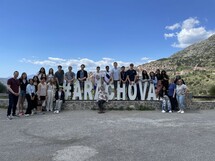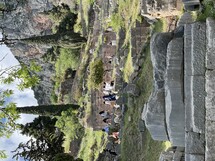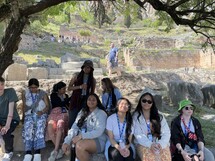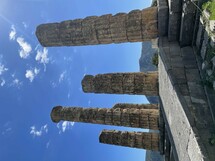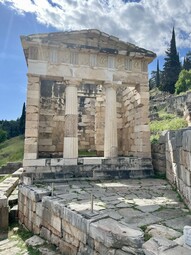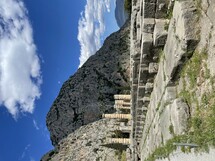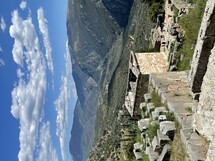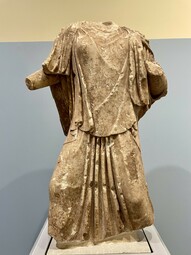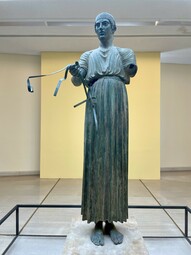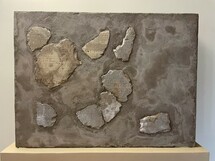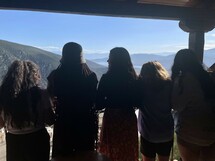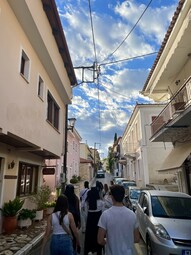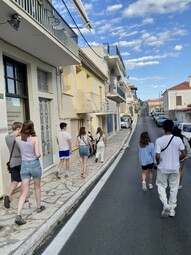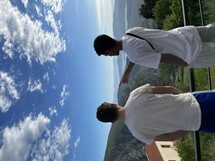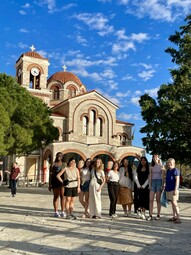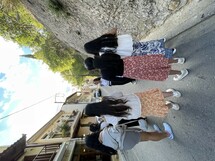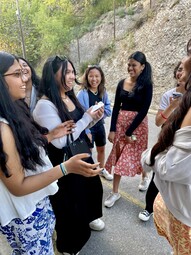Day 5: Delphi
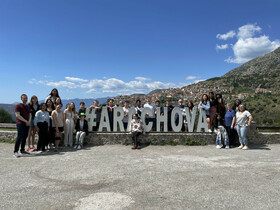
We start the day with breakfast at the hotel as per usual. Mr. Hartley is adjusting particularly well to the Mediterranean diet: cake for breakfast and gelato for lunch. The four hour drive from Corinth to Delphi takes us through the mountains of Greece. 70% of Greece is actually mountainous, an often overlooked detail about the country! Wind turbines sit at the top of the lower mountain peaks. We pull over at a scenic outlook over the town of Arachova to marvel at its picturesque nature… and we take a picture before we have a delicious lunch.
We arrive in Delphi and are guided through the Temple of Apollo site by our local guide, Penny before having some free time to explore. This is a large site built on an inclining hill, with the ruins of a number of ancient buildings but it is only a small glimpse into the extravagance and immensity of this place in the past. The more prominent ruins include the entrance, called the Athena Pronaia, the agora (marketplace), the treasury, the Temple of Apollo, and the theater.
The first goddess that is worshiped at Delphi is Gaia, the goddess of earth and mother of all life. Delphi was considered a sacred place because Gaia was very active here in the form of earthquakes and vapors that would rise from the earth. The further you go back in history, the more you see the worship of women, because they were capable of the most profound mystery; the mystery of creating life. Delphi comes from the Greek word for “womb” for this reason.
As you walk up the hill, you pass through the ancient agora, the marketplace, where the ancients could purchase gifts to offer to Apollo. The Temple of Apollo is built in Delphi because Apollo came to Delphi chasing a snake and killed the snake in Delphi. What is interesting is that the snake was a symbol of mother earth and of healing because of its ability to regenerate its skin and its connection to the ground itself. The pharmacies in Greece have the symbol of the snake for this reason.
We learn that many Greeks, when trying to decide how to interact with the other city-states, would visit Apollo’s Temple to seek an oracle or an answer to a specific question. There are limited resources in the mediterranean, specifically limited land, which means limited areas to grow to food and this geography impacts how the city-states interact with each other. Do they collaborate or war?
The prophetess would sit in the middle of the temple and breathe in the vapors from the earth, what we now know was methane and ethane gas, and deliver an oracle that would be written down by a priest and given as an answer. The gas is poisonous, so this was done once a year, but as it became more popular, it was done once a month. This is also why they had four or five prophetesses and not just one.
But here is the problem: all the city-states in the Mediterranean serve the same gods… so the gods can’t take sides. This is why Apollo’s other name means “one who does not give direct answers”. In one story, Apollo is asked “Do I attack the enemy first or wait for them to attack us?” and Apollo’s answer is “if you sail across the sea, one kingdom will fall”. Some may see this as a tricky answer. Our guide sees it as a diplomatic answer. You don’t need an enemy to destroy your kingdom; you can do it yourself.
You see, the philosophy of this temple is about being able to see the long-term consequences of our actions. Think of the story of Icarus; it is a warning: if you fly too close to the sun or too close to the water, you will fall. In other words, we need to avoid extremes, manage our emotions, self-reflect, reason and think before we act. Know thyself.
There is value in these teachings but I think we can all agree that alone, it leaves a lot lacking in terms of the meaning of our lives. Proverbs says the fear of the Lord is the beginning of wisdom and knowledge of the Holy One is understanding. How blessed we are to know that our God is always with us, guiding and shaping who we are and the lives we live as we surrender to him. We can seek direction for decision-making from him in prayer.
After finishing at the site, we have time to explore the Museum of Delphi. The artifacts all came from the site at Delphi and painted a better picture of what it would have looked like. I was particularly struck by the precise attention to detail and time it would have taken to create the numerous statues of men, women, and the gods that would have been scattered throughout the entire site. These statues were also immaculately crafted, displaying the human form, the movement of fabric, and even using different gemstones to create an incredibly realistic eye and eyelashes. The capacity for creativity and skill that we have from God is stunning.
We also find a surprise connection to Paul at this site. Scholars did not know how long Paul was in Corinth until they discovered an inscription in Delphi that they were able to cross-reference with other known facts to ascertain the chronology of the life of Paul.
As we drive into the town of Delphi itself, we find it has one-way, narrow streets lined with buildings, balconies, colorful doorways, and flowers. We unpack and then some of us head out to explore the town. The streets are steep; it's easy to go one way down the street and harder to hike back up the other. We enjoy dinner in Delphi and spend more time exploring the shops.
Keagan has become our whole group’s resident zoologist. He can frequently be found standing a bit separately from the group and facing a different direction, noticing the flora and fauna of the area that no one else does. He notices the call of the morning doves on the first day, spots a turtle in a tuft of grass at the Athenian agora and finds a wall lizard. Now, when we want to know what a bird, or insect, or plant is, we ask Keagan.
I also wanted to say that your children are hilarious and we have loved laughing with them this week. When we were at the archaeological site of Corinth, I asked about a certain kind of bird and Landon replied with perfect comedic timing: “Well that’s a gray-feathered Corinth; I know it well”. At dinner tonight, Madeline had a list of saved phrases and sayings that had our table in stitches. This evening, I watched Astria, Milette, Marlena, Serah, Jeamor, Khariz, and Bless record a TikTok video and burst out laughing after every take.
We are officially halfway through, something students pointed out to me but promptly say not to think too hard about. I think I will do just that.
Comments
Carla Rae Shaw
PostedReally enjoying these posts, Megan! Beautiful photos and stories! Continuing to pray for safe travels, good health, and revelation for all of you! Looks like the Lord has been blessing you with amazing weather! May it continue!

